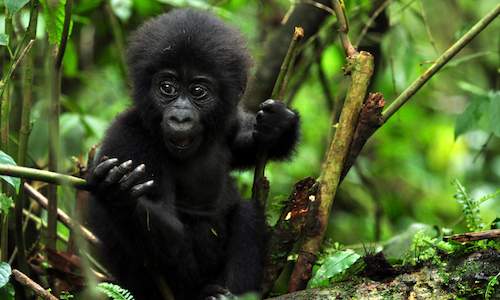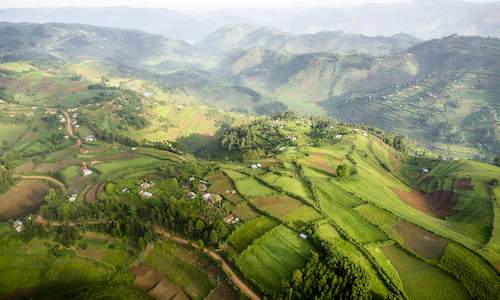Uganda
Road Less Travelled
Travel to Uganda with a sense of adventure and you will be rewarded with spectacular scenery, friendly people, enthralling bird life and very few other tourists competing for the same magnificent sights.It is not necessary to be an intrepid traveller to visit Uganda but it helps! Carrie Hampton gets you drunk on banana gin, takes you up river to encounter giant crocodiles and weird birds, and into the impenetrable jungle to come face to face with chest-pounding gorillas. Join her on the road less travelled.
If at times you find service with a smile lacking, it is simply due to lack of practice as tourists have been noticeably absent from Uganda for many years - until recently that is. A stable government,
rapidly improving infrastructure, sound environmental policies and a willingness to learn from past mistakes are just some reasons why Uganda's tourist industry is set to flourish.
The Government owned Uganda Hotels have begun their privatisation policy and prime sites have been
snapped up by astute holiday companies. The stunningly situated Paara Lodge, high on the banks of the Victoria Nile has been renovated to top international standards at five star prices.
At the moment though, there are still many which are shabby and run down with beds that sag and hot water which is not hot, or worse - no water at all.
Remember your sense of adventure and your sense of humour and do not let these little things put you off.
Bottom-Numbing Roads
Be prepared too for bumpy red-dirt roads and
bottom-numbing journeys of several hours at speeds of no more than 40 kph if you are in the north and west of the country. Murchison Falls National Park in the north-west (previously called the Kabalega Falls National Park) must not be left out of your itinerary.
Accessible from the capital city Kampala on tarmac roads in six hours, but from any other direction
the dreaded dirt roads will leave you covered in a robe of fine red dust or if you foolishly attempt it during the west season, will find you firmly stuck in orange treacle.
Spectacular for its power not its size, Murchison Falls is the point at which the whole of the Victoria Nile funnels furiously through a gap just 21 feet wide into the deservedly named 'Boiling Pot'. Then at the height of its anger, it explodes through another 21-foot gap tumbling 120 feet in
a thunderous foaming torrent.
A little way downstream at Paraa where the lodge stands majestic, 'The Shoebill' river-boat will take you on one of
the most stunning boat rides in the world. Blink and you wake up in a Tarzan movie with monstrously huge Nile crocodiles imitating rocks and sunbathing with gaping toothy grins.
Literally thousands of pink-eared hippos of varying sizes bob up and down like bathtime toys occasionally terrifying you with a sudden mock charge. Buffalo wade nonchalantly through the prolific floating water-ice plants fringing the river-bank and a herd of
over a hundred elephants cool themselves, playing dead on their sides in a shallow creek or grazing silently on the lush grasses.
Bizarre Birds
I have never seen
so much diversity of wildlife in one hour and I did not know whether to stare at a white-fronted fish eagle on the right riverbank, to watch a shy water buck on the other or to follow a darting kingfisher until it caught its fish.
Bird spotters will be overwhelmed especially if they are lucky enough to see the
bizarre looking and very rare shoebill (or whale-headed) stork which stood alone in the reeds looking wierd. It was four feet high with a head like a wobbly wooden mallet and a timid pouting expression.
A similar boat trip, but without such overwhelming abundance can be taken further south on the Kasinga Channel connecting Lake Edward with Lake Albert in the Queen Elizabeth National Park. The
trip can be booked in advance (which is probably not necessary) or in person from the Mweya Lodge - a beautiful hotel perched high on the peninsula overlooking the Kasinga Channel.
It is one of the better hotels you will encounter in rural Uganda and it is a delight to sit on the elevated grassed terrace
watching the striking African sunset, while warthogs crop the lawn and hippo grunt just the other side of the hedge.
Maps are There to Confuse You
When looking at maps of Uganda, you may be forgiven for being a little confused. Several of the National Parks and
lakes have changed their names more than once since independence in 1962, and the maps have not kept up with the changes. For example the Queen Elizabeth National Park was called the Ruwenzori National Park for many years until it returned to its royal colonial name.
Meanwhile the Ruwenzori Mountains, north of Queen Elizabeth N.P. were formed into
the new Ruwenzori National Park in 1991. If your map shows the Ruwenzori N.P. lying south of Kasese then you are actually looking at the Queen Elizabeth N.P. Confused? You will be.
Banana Booze
Further south from the Queen Elizabeth N.P. is the 'Switzerland of Africa'. Here are the lush cultivated hillsides of the Kigeza district, where another
opportunity for a boat ride presented itself.
From the restful grassy banks of Lake Bunyoni, you can
hire a dug-out eucalyptus canoe and the owner will paddle you to one of the many small islands where you can stay the night in a cabin or hired tent. The kingfishers were still in abundance but gone were the hippos, crocs, elephants and buffalo.
Every slope, vertical or not was cultivated with bananas - the staple diet of Uganda. The big green plantain bananas are steamed and mashed into a tasty savory dish called Matoke or distilled into
lumpy banana homebrew beer called Tonto. This or Waragi (banana gin) is often responsible for an entire village being drunk on market days.
Uganda's terrain is so varied, but always green and lush and exuding fertility. The foothills of the Ruwenzori 'Mountains of the Moon', sprout
twenty foot high stamens of the giant lobelia - nothing like those nice little blue lobelia in European window boxes - and every plant seemed to have a medicinal purpose (more often than not to cure impotence).
Thus the milky sap of an
epiphytic vine is added to tonto or whisky (which I would have thought would induce brewers droop not cure it).
In the Ruwenzori range is
Africa's third highest mountain, Mt Stanley, with its Margherita Peak at 16,757 feet. This challenges even the most experienced climbers and is far too demanding and dangerous for ordinary hikers.
Charging Gorillas
One very special reason many people visit Uganda is to see some of the
last Mountain Gorillas left on earth. They reside in the heart of the Bwindi Impenetrable Forest - a steep slippery rainforest which lives up to its name.
'If the silverback charges, look down and do not run!' These words of wisdom from the rangers are in opposition to your natural fight or flight instincts, which tell you to get the hell out of there! When the
400-pound dominant male makes a mock charge, he also pounds his chest - yes he really does do that - and the noise is enough to make you think your world is about to end, and the instinct to run is almost overwhelming.
Only a small number of people are allowed in each day to
track several gorilla groups and may only stay with them for one hour. Looking into the eyes of our not-so-distant cousins in their own environment, is one of the most moving experiences you may ever have.
Uganda has mountains to
challenge the most experienced mountaineer, jungles to entangle the most intrepid adventurer and lush green scenery to soften the hardest heart. Go now to experience it in all its natural glory.
Author Carrie Hampton can be contacted on email: carrieh@iafrica.com
Copyright © 2002 Carrie Hampton. All rights reserved. Reproduction in whole or in part without the permission of the author is prohibited

These gorilla trekking tours in Uganda included guided treks into the jungles and National Parks of Uganda to see Gorillas up close. The bes...
more
Information on travelling in Uganda including the best destinations for Gorilla and Chimpanzee treks and safaris....
more

 These gorilla trekking tours in Uganda included guided treks into the jungles and National Parks of Uganda to see Gorillas up close. The bes...
These gorilla trekking tours in Uganda included guided treks into the jungles and National Parks of Uganda to see Gorillas up close. The bes... Information on travelling in Uganda including the best destinations for Gorilla and Chimpanzee treks and safaris....
Information on travelling in Uganda including the best destinations for Gorilla and Chimpanzee treks and safaris....